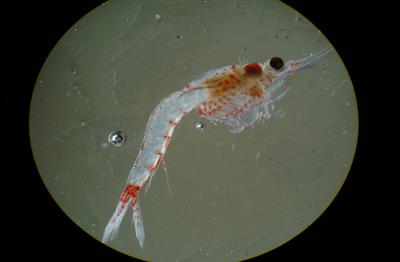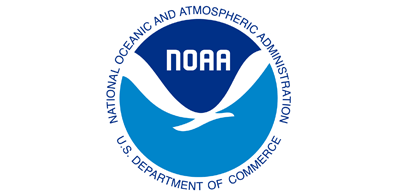Bloody Red Shrimp

Species at a Glance
The bloody red shrimp (Hemimysis anomala) is a tiny freshwater crustacean in the order Mysidacea; more commonly referred to as mysids. Mysids are also sometimes called opossum shrimp because females typically carry their eggs in a pouch.
Species Description
These shrimp are very small, with males reaching only 8-10 mm and females reaching 11-16 mm. They have large stalked eyes and eight pairs of legs. They are typically red to orange in color due to pigmented cells called chromatophores; however, coloration can be highly variable and change with varying light and temperature conditions. Some individuals lack color completely and are ivory or translucent. Without a microscope, the best way to distinguish the bloody red shrimp from other shrimp is by counting legs — it has eight pairs of legs, while most other larger shrimps and decapods have five pairs. In addition its unique swarming behavior is unlikely to be confused with anything else in the Great Lakes. With magnification, the bloody red shrimp has a distinctive flat-ended tail with two prominent spikes.
Native & Introduced Ranges
Native to the Ponto-Caspian region of Eastern Europe, the bloody red shrimp was first reported in the United States in 2006 in Muskegon Lake, which is connected to Lake Michigan. Since then, the monitoring network that was established to track its distribution throughout the Great Lakes has found populations in lakes Michigan, Ontario, and Erie. In Pennsylvania, the closest known infestation is about 60 miles north of Erie near Dunkirk, New York; therefore, yearly monitoring for this species takes place near Presque Isle in Lake Erie.
Biology & Spread
The bloody red shrimp was most likely introduced into the Great Lakes through ballast water discharges from ocean-going ships. However, mysids may also be used by aquarists as a high-nutrition food for aquarium fish, and although there are no records showing that the bloody red shrimp is used this way, it could represent a possible vector. Once this shrimp was introduced to the Great Lakes, subsequent spread to inter-basin areas has occurred through bait bucket transfers, hitchhiking in live wells, bilges, boat motors, trailers, and hulls, or other equipment used in the water.
Habitat
During the day, reddish swarms of bloody red shrimp can be seen aggregating in the shadowy areas of piers, boats, breakwalls, or rocky crevices. They prefer hard bottom surfaces including rocks and shells and will avoid soft bottoms, vegetation, and sunlight.At night swarms disperse into deeper waters, but may be detected by shining a bright light on the water.
Impacts
Threat to Biodiversity
Because of its history of invading canals, streams, lakes, and reservoirs throughout Europe, the bloody red shrimp is considered a high risk for invading inland lakes in the Great Lakes region. Since this omnivore eats a variety of smaller animals including waterfleas and algae, it is in direct competition with other aquatic organisms including young fish. However, they may be a potential food source for larger planktivorous fish.
Prevention & Control
Early detection is the first line of defense in preventing the spread of this species to new areas. Know how to identify the bloody red shrimp and distinguish it from native shrimp.
- Always check for and remove plants, mud, and debris from boats, trailers, clothing, and equipment before entering a water body and before leaving a water body.
- Drain all water from bait buckets, bilges, and live wells before transporting to new areas.
- Clean all gear and equipment with hot water or salt water, OR let boats and equipment dry thoroughly for at least five days before entering a new water body.
References:
- NOAA Great Lakes Environmental Research Laboratory. 2007. Bloody Red Shrimp (Hemimysis anomala). Fact Sheet.
- Reid, D.F., Sturtevant, R., and Pothoven, S. 2007. Calling on the Public: Where in the Great Lakes is the
- Newest Aquatic Invader, Hemimysis anomala? Aquatic Invaders Digest of National Aquatic Nuisance Species Clearinghouse. 18 (1): 1-7.



